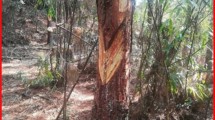Abstract
Manipulations of production systems in rubber tree which were intended to improve sucrose translocation in tapped bark resulted in an increase of latex sucrose and of latex production and reduced the incidence of nonyielding laticiferous tissue. This was achieved by shortening the tapping cut from full to half spiral, by changing the descending direction into an ascending mode of tapping or by annual change-over of tapping panel allowing for a longer time the regeneration of bark removed above the location of the cut. The increase of latex yield did not result in a significant decrease in the growth of trees over a period of three years.
Clonal differences in nonyielding bark appeared to be related to differences in sucrose depletion by tapping. In clone PB 235 which exhibited low latex sucrose, a reduction of tapping frequency resulted in an increase in sucrose level and in a decrease of bark “dryness” tending to an increase in total yield.
The tapping manipulations examined did not affect latex flow characteristics such as the plugging index of latex vessels and the bursting index of lutoids. The results stress the importance of photosynthate allocation for the physiology of laticiferous system productivity and indicate the possibilities of improving assimilate economy in rubber trees.
Similar content being viewed by others
References
Archer, B. L., Barnard, D., Cockbain, E. G., Dickenson, P. B., McMullen, A. I.: Structure, composition and biochemistry ofHevea latex. - In:Bateman, L. (ed.): The Chemistry and Physics of Rubber-like Substances. Pp. 41–72. Maclaren, London 1963.
Bealing, F. J., Chua, S. E.: Output, composition and metabolic activity ofHevea latex in relation to tapping intensity and the onset of brown bast. - J. Rubb. Res. Inst. Malaya23: 204–231, 1972.
Chong, F. C.: The role of carbohydrates in the exploitation and latex flow ofHevea. - Thesis summary, Univ. Ghent, Belgium. J. Rubb. Res. Inst. Malaysia29: 125–126, 1981.
Dickenson, P. B.: The ultrastructure of the latex vesselsof Hevea brasiliensis. - In:Mullins, L. (ed.): The Proceedings of the Natural Rubber Procedures Research Association Jubilee Conference, Cambridge 1964. Pp. 52–66. Maclaren, London 1965.
Esohbach, J.-M., Roussel, D., Van de Sype, H., Jacob, J.-L., D’Auzac, J.: Relationships between yield and clonal physiological characteristics of latex fromHevea brasiliensis. -Physiol. vég.22: 295–304, 1984.
Hansen, G. K.: Utilization of photosynthates for growth, respiration, and storage in tops and roots ofLolium multiflorum. -Physiol. Plant.42: 5–13, 1978.
Hebant, C., De Fay, F.: Functional organization of the bark pfHevea brasiliensis (rubber tree): A structural and histoenzymological study. - Z. Pflanzenphysiol.97: 391–398, 1980.
Low, F. C.: Distribution and concentration of major soluble carbohydrates inHevea latex, the effects of Ethephon stimulation and the possible role of these carbohydrates in latex flow. - J. Rubb. Res. Inst. Malaysia26: 21–32, 1978.
Low, F. C., Gomez, J. B.: Carbohydrate status of exploitedHevea I: The effect of different exploitation systems on the concentration of the major soluble carbohydrates in latex. - J. Rubb. Res. Inst. Malaysia30: 1–18, 1982.
Templeton, J. K.: Partition of assimilates. - J. Rubb. Res. Inst. Malaya21: 259–263, 1969.
Tupý, J.: Stimulatory effects of 2,4-dichlorophenoxyacetic acid and of 1-naphthylacetic acid on sucrose level, invertase activity and sucrose utilization in the latex ofHevea brasiliensis. - Planta88: 144–153, 1969.
Tupý, J.: Influence de la stimulation hormonale de la production sur la teneur en saccharose du latex d’Heveabrasiliensis. - Rev. gén. Caout. Plast.50: 311–314, 1973a.
Tupý, J.: The activity of latex invertase and latex production inHevea brasiliensis Müll. Arg. - Physiol. vég.11: 633–641, 1973b.
Tupý, J.: Some aspects of sucrose transport and utilization in latex producing bark ofHevea brasiliensis Muel. Arg. -Biol. Plant.27: 51–64, 1985.
Tupý, J., Resing, W. L.: Anaerobic respiration in latex ofHevea brasiliensis substrate and limiting factors. - Biol. Plant.10: 72–80, 1968.
Wareing, P. F., Patrick, J.: Source-sink relations and the partition of assimilates in the plant - In:Cooper, J. P. (ed.): Photosynthesis and Productivity in Different Environments. Pp. 481–499. Cambridge Univ. Press, Cambridge-London-New York-Melbourne 1975.
Author information
Authors and Affiliations
Additional information
On mission as export of the International Atomic Energy Agency.
Rights and permissions
About this article
Cite this article
Eschbach, J.M., Tupý, J. & Lacrotte, R. Photosynthate allocation and productivity of latex vessels inHevea brasiliensis . Biol Plant 28, 321–328 (1986). https://doi.org/10.1007/BF02902242
Received:
Accepted:
Issue Date:
DOI: https://doi.org/10.1007/BF02902242



